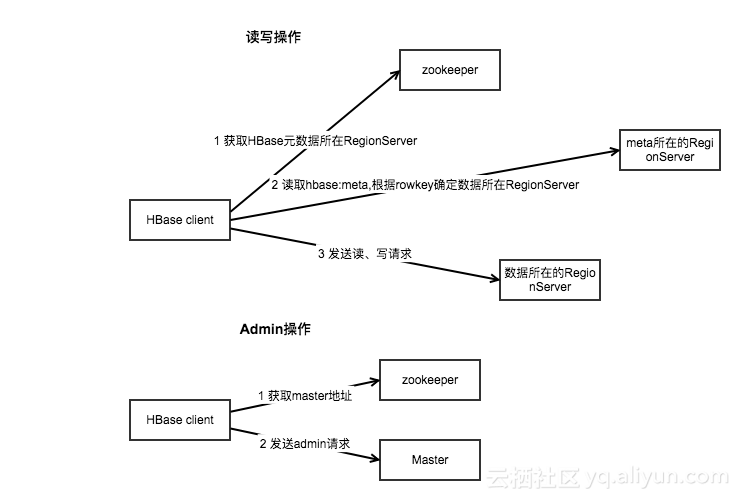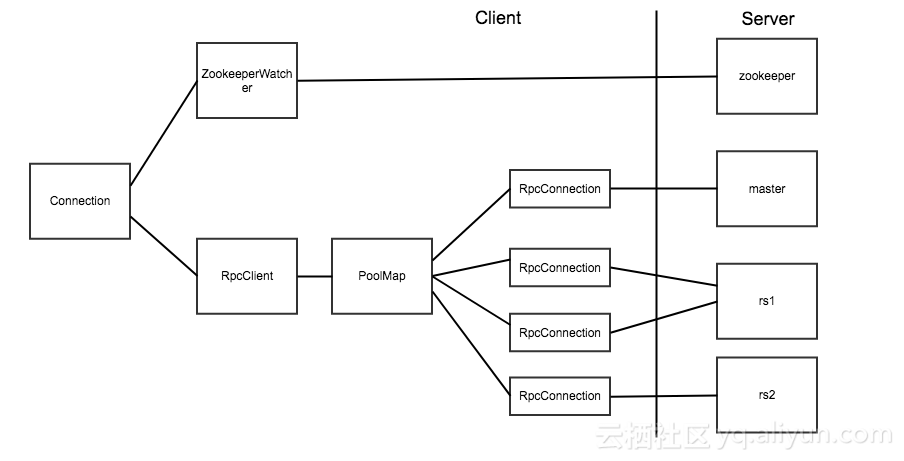HBase 学习之路(六)——HBase Java API 的基本使用
一、简述
截至到目前(2019.04),HBase 有两个主要的版本,分别是1.x 和 2.x ,两个版本的Java API有所不同,1.x 中某些方法在2.x中被标识为@deprecated过时。所以下面关于API的样例,我会分别给出1.x和2.x两个版本。完整的代码见本仓库:
同时你使用的客户端的版本必须与服务端版本保持一致,如果用2.x版本的客户端代码去连接1.x版本的服务端,会抛出NoSuchColumnFamilyException等异常。
二、Java API 1.x 基本使用
2.1 新建Maven工程,导入项目依赖
要使用Java API 操作HBase,需要引入hbase-client。这里选取的HBase Client的版本为1.2.0。
<dependency>
<groupId>org.apache.hbase</groupId>
<artifactId>hbase-client</artifactId>
<version>1.2.0</version>
</dependency>
2.2 API 基本使用
public class HBaseUtils {
private static Connection connection;
static {
Configuration configuration = HBaseConfiguration.create();
configuration.set("hbase.zookeeper.property.clientPort", "2181");
// 如果是集群 则主机名用逗号分隔
configuration.set("hbase.zookeeper.quorum", "hadoop001");
try {
connection = ConnectionFactory.createConnection(configuration);
} catch (IOException e) {
e.printStackTrace();
}
}
/**
* 创建HBase表
*
* @param tableName 表名
* @param columnFamilies 列族的数组
*/
public static boolean createTable(String tableName, List<String> columnFamilies) {
try {
HBaseAdmin admin = (HBaseAdmin) connection.getAdmin();
if (admin.tableExists(tableName)) {
return false;
}
HTableDescriptor tableDescriptor = new HTableDescriptor(TableName.valueOf(tableName));
columnFamilies.forEach(columnFamily -> {
HColumnDescriptor columnDescriptor = new HColumnDescriptor(columnFamily);
columnDescriptor.setMaxVersions(1);
tableDescriptor.addFamily(columnDescriptor);
});
admin.createTable(tableDescriptor);
} catch (IOException e) {
e.printStackTrace();
}
return true;
}
/**
* 删除hBase表
*
* @param tableName 表名
*/
public static boolean deleteTable(String tableName) {
try {
HBaseAdmin admin = (HBaseAdmin) connection.getAdmin();
// 删除表前需要先禁用表
admin.disableTable(tableName);
admin.deleteTable(tableName);
} catch (Exception e) {
e.printStackTrace();
}
return true;
}
/**
* 插入数据
*
* @param tableName 表名
* @param rowKey 唯一标识
* @param columnFamilyName 列族名
* @param qualifier 列标识
* @param value 数据
*/
public static boolean putRow(String tableName, String rowKey, String columnFamilyName, String qualifier,
String value) {
try {
Table table = connection.getTable(TableName.valueOf(tableName));
Put put = new Put(Bytes.toBytes(rowKey));
put.addColumn(Bytes.toBytes(columnFamilyName), Bytes.toBytes(qualifier), Bytes.toBytes(value));
table.put(put);
table.close();
} catch (IOException e) {
e.printStackTrace();
}
return true;
}
/**
* 插入数据
*
* @param tableName 表名
* @param rowKey 唯一标识
* @param columnFamilyName 列族名
* @param pairList 列标识和值的集合
*/
public static boolean putRow(String tableName, String rowKey, String columnFamilyName, List<Pair<String, String>> pairList) {
try {
Table table = connection.getTable(TableName.valueOf(tableName));
Put put = new Put(Bytes.toBytes(rowKey));
pairList.forEach(pair -> put.addColumn(Bytes.toBytes(columnFamilyName), Bytes.toBytes(pair.getKey()), Bytes.toBytes(pair.getValue())));
table.put(put);
table.close();
} catch (IOException e) {
e.printStackTrace();
}
return true;
}
/**
* 根据rowKey获取指定行的数据
*
* @param tableName 表名
* @param rowKey 唯一标识
*/
public static Result getRow(String tableName, String rowKey) {
try {
Table table = connection.getTable(TableName.valueOf(tableName));
Get get = new Get(Bytes.toBytes(rowKey));
return table.get(get);
} catch (IOException e) {
e.printStackTrace();
}
return null;
}
/**
* 获取指定行指定列(cell)的最新版本的数据
*
* @param tableName 表名
* @param rowKey 唯一标识
* @param columnFamily 列族
* @param qualifier 列标识
*/
public static String getCell(String tableName, String rowKey, String columnFamily, String qualifier) {
try {
Table table = connection.getTable(TableName.valueOf(tableName));
Get get = new Get(Bytes.toBytes(rowKey));
if (!get.isCheckExistenceOnly()) {
get.addColumn(Bytes.toBytes(columnFamily), Bytes.toBytes(qualifier));
Result result = table.get(get);
byte[] resultValue = result.getValue(Bytes.toBytes(columnFamily), Bytes.toBytes(qualifier));
return Bytes.toString(resultValue);
} else {
return null;
}
} catch (IOException e) {
e.printStackTrace();
}
return null;
}
/**
* 检索全表
*
* @param tableName 表名
*/
public static ResultScanner getScanner(String tableName) {
try {
Table table = connection.getTable(TableName.valueOf(tableName));
Scan scan = new Scan();
return table.getScanner(scan);
} catch (IOException e) {
e.printStackTrace();
}
return null;
}
/**
* 检索表中指定数据
*
* @param tableName 表名
* @param filterList 过滤器
*/
public static ResultScanner getScanner(String tableName, FilterList filterList) {
try {
Table table = connection.getTable(TableName.valueOf(tableName));
Scan scan = new Scan();
scan.setFilter(filterList);
return table.getScanner(scan);
} catch (IOException e) {
e.printStackTrace();
}
return null;
}
/**
* 检索表中指定数据
*
* @param tableName 表名
* @param startRowKey 起始RowKey
* @param endRowKey 终止RowKey
* @param filterList 过滤器
*/
public static ResultScanner getScanner(String tableName, String startRowKey, String endRowKey,
FilterList filterList) {
try {
Table table = connection.getTable(TableName.valueOf(tableName));
Scan scan = new Scan();
scan.setStartRow(Bytes.toBytes(startRowKey));
scan.setStopRow(Bytes.toBytes(endRowKey));
scan.setFilter(filterList);
return table.getScanner(scan);
} catch (IOException e) {
e.printStackTrace();
}
return null;
}
/**
* 删除指定行记录
*
* @param tableName 表名
* @param rowKey 唯一标识
*/
public static boolean deleteRow(String tableName, String rowKey) {
try {
Table table = connection.getTable(TableName.valueOf(tableName));
Delete delete = new Delete(Bytes.toBytes(rowKey));
table.delete(delete);
} catch (IOException e) {
e.printStackTrace();
}
return true;
}
/**
* 删除指定行的指定列
*
* @param tableName 表名
* @param rowKey 唯一标识
* @param familyName 列族
* @param qualifier 列标识
*/
public static boolean deleteColumn(String tableName, String rowKey, String familyName,
String qualifier) {
try {
Table table = connection.getTable(TableName.valueOf(tableName));
Delete delete = new Delete(Bytes.toBytes(rowKey));
delete.addColumn(Bytes.toBytes(familyName), Bytes.toBytes(qualifier));
table.delete(delete);
table.close();
} catch (IOException e) {
e.printStackTrace();
}
return true;
}
}
2.3 单元测试
以单元测试的方式对上面封装的API进行测试。
public class HBaseUtilsTest {
private static final String TABLE_NAME = "class";
private static final String TEACHER = "teacher";
private static final String STUDENT = "student";
@Test
public void createTable() {
// 新建表
List<String> columnFamilies = Arrays.asList(TEACHER, STUDENT);
boolean table = HBaseUtils.createTable(TABLE_NAME, columnFamilies);
System.out.println("表创建结果:" + table);
}
@Test
public void insertData() {
List<Pair<String, String>> pairs1 = Arrays.asList(new Pair<>("name", "Tom"),
new Pair<>("age", "22"),
new Pair<>("gender", "1"));
HBaseUtils.putRow(TABLE_NAME, "rowKey1", STUDENT, pairs1);
List<Pair<String, String>> pairs2 = Arrays.asList(new Pair<>("name", "Jack"),
new Pair<>("age", "33"),
new Pair<>("gender", "2"));
HBaseUtils.putRow(TABLE_NAME, "rowKey2", STUDENT, pairs2);
List<Pair<String, String>> pairs3 = Arrays.asList(new Pair<>("name", "Mike"),
new Pair<>("age", "44"),
new Pair<>("gender", "1"));
HBaseUtils.putRow(TABLE_NAME, "rowKey3", STUDENT, pairs3);
}
@Test
public void getRow() {
Result result = HBaseUtils.getRow(TABLE_NAME, "rowKey1");
if (result != null) {
System.out.println(Bytes
.toString(result.getValue(Bytes.toBytes(STUDENT), Bytes.toBytes("name"))));
}
}
@Test
public void getCell() {
String cell = HBaseUtils.getCell(TABLE_NAME, "rowKey2", STUDENT, "age");
System.out.println("cell age :" + cell);
}
@Test
public void getScanner() {
ResultScanner scanner = HBaseUtils.getScanner(TABLE_NAME);
if (scanner != null) {
scanner.forEach(result -> System.out.println(Bytes.toString(result.getRow()) + "->" + Bytes
.toString(result.getValue(Bytes.toBytes(STUDENT), Bytes.toBytes("name")))));
scanner.close();
}
}
@Test
public void getScannerWithFilter() {
FilterList filterList = new FilterList(FilterList.Operator.MUST_PASS_ALL);
SingleColumnValueFilter nameFilter = new SingleColumnValueFilter(Bytes.toBytes(STUDENT),
Bytes.toBytes("name"), CompareOperator.EQUAL, Bytes.toBytes("Jack"));
filterList.addFilter(nameFilter);
ResultScanner scanner = HBaseUtils.getScanner(TABLE_NAME, filterList);
if (scanner != null) {
scanner.forEach(result -> System.out.println(Bytes.toString(result.getRow()) + "->" + Bytes
.toString(result.getValue(Bytes.toBytes(STUDENT), Bytes.toBytes("name")))));
scanner.close();
}
}
@Test
public void deleteColumn() {
boolean b = HBaseUtils.deleteColumn(TABLE_NAME, "rowKey2", STUDENT, "age");
System.out.println("删除结果: " + b);
}
@Test
public void deleteRow() {
boolean b = HBaseUtils.deleteRow(TABLE_NAME, "rowKey2");
System.out.println("删除结果: " + b);
}
@Test
public void deleteTable() {
boolean b = HBaseUtils.deleteTable(TABLE_NAME);
System.out.println("删除结果: " + b);
}
}
三、Java API 2.x 基本使用
3.1 新建Maven工程,导入项目依赖
这里选取的HBase Client的版本为最新的2.1.4。
<dependency>
<groupId>org.apache.hbase</groupId>
<artifactId>hbase-client</artifactId>
<version>2.1.4</version>
</dependency>
3.2 API 的基本使用
2.x 版本相比于1.x 废弃了一部分方法,关于废弃的方法在源码中都会指明新的替代方法,比如,在2.x中创建表时:HTableDescriptor和HColumnDescriptor等类都标识为废弃,取而代之的是使用TableDescriptorBuilder和ColumnFamilyDescriptorBuilder来定义表和列族。

以下为HBase 2.x 版本Java API的使用示例:
public class HBaseUtils {
private static Connection connection;
static {
Configuration configuration = HBaseConfiguration.create();
configuration.set("hbase.zookeeper.property.clientPort", "2181");
// 如果是集群 则主机名用逗号分隔
configuration.set("hbase.zookeeper.quorum", "hadoop001");
try {
connection = ConnectionFactory.createConnection(configuration);
} catch (IOException e) {
e.printStackTrace();
}
}
/**
* 创建HBase表
*
* @param tableName 表名
* @param columnFamilies 列族的数组
*/
public static boolean createTable(String tableName, List<String> columnFamilies) {
try {
HBaseAdmin admin = (HBaseAdmin) connection.getAdmin();
if (admin.tableExists(TableName.valueOf(tableName))) {
return false;
}
TableDescriptorBuilder tableDescriptor = TableDescriptorBuilder.newBuilder(TableName.valueOf(tableName));
columnFamilies.forEach(columnFamily -> {
ColumnFamilyDescriptorBuilder cfDescriptorBuilder = ColumnFamilyDescriptorBuilder.newBuilder(Bytes.toBytes(columnFamily));
cfDescriptorBuilder.setMaxVersions(1);
ColumnFamilyDescriptor familyDescriptor = cfDescriptorBuilder.build();
tableDescriptor.setColumnFamily(familyDescriptor);
});
admin.createTable(tableDescriptor.build());
} catch (IOException e) {
e.printStackTrace();
}
return true;
}
/**
* 删除hBase表
*
* @param tableName 表名
*/
public static boolean deleteTable(String tableName) {
try {
HBaseAdmin admin = (HBaseAdmin) connection.getAdmin();
// 删除表前需要先禁用表
admin.disableTable(TableName.valueOf(tableName));
admin.deleteTable(TableName.valueOf(tableName));
} catch (Exception e) {
e.printStackTrace();
}
return true;
}
/**
* 插入数据
*
* @param tableName 表名
* @param rowKey 唯一标识
* @param columnFamilyName 列族名
* @param qualifier 列标识
* @param value 数据
*/
public static boolean putRow(String tableName, String rowKey, String columnFamilyName, String qualifier,
String value) {
try {
Table table = connection.getTable(TableName.valueOf(tableName));
Put put = new Put(Bytes.toBytes(rowKey));
put.addColumn(Bytes.toBytes(columnFamilyName), Bytes.toBytes(qualifier), Bytes.toBytes(value));
table.put(put);
table.close();
} catch (IOException e) {
e.printStackTrace();
}
return true;
}
/**
* 插入数据
*
* @param tableName 表名
* @param rowKey 唯一标识
* @param columnFamilyName 列族名
* @param pairList 列标识和值的集合
*/
public static boolean putRow(String tableName, String rowKey, String columnFamilyName, List<Pair<String, String>> pairList) {
try {
Table table = connection.getTable(TableName.valueOf(tableName));
Put put = new Put(Bytes.toBytes(rowKey));
pairList.forEach(pair -> put.addColumn(Bytes.toBytes(columnFamilyName), Bytes.toBytes(pair.getKey()), Bytes.toBytes(pair.getValue())));
table.put(put);
table.close();
} catch (IOException e) {
e.printStackTrace();
}
return true;
}
/**
* 根据rowKey获取指定行的数据
*
* @param tableName 表名
* @param rowKey 唯一标识
*/
public static Result getRow(String tableName, String rowKey) {
try {
Table table = connection.getTable(TableName.valueOf(tableName));
Get get = new Get(Bytes.toBytes(rowKey));
return table.get(get);
} catch (IOException e) {
e.printStackTrace();
}
return null;
}
/**
* 获取指定行指定列(cell)的最新版本的数据
*
* @param tableName 表名
* @param rowKey 唯一标识
* @param columnFamily 列族
* @param qualifier 列标识
*/
public static String getCell(String tableName, String rowKey, String columnFamily, String qualifier) {
try {
Table table = connection.getTable(TableName.valueOf(tableName));
Get get = new Get(Bytes.toBytes(rowKey));
if (!get.isCheckExistenceOnly()) {
get.addColumn(Bytes.toBytes(columnFamily), Bytes.toBytes(qualifier));
Result result = table.get(get);
byte[] resultValue = result.getValue(Bytes.toBytes(columnFamily), Bytes.toBytes(qualifier));
return Bytes.toString(resultValue);
} else {
return null;
}
} catch (IOException e) {
e.printStackTrace();
}
return null;
}
/**
* 检索全表
*
* @param tableName 表名
*/
public static ResultScanner getScanner(String tableName) {
try {
Table table = connection.getTable(TableName.valueOf(tableName));
Scan scan = new Scan();
return table.getScanner(scan);
} catch (IOException e) {
e.printStackTrace();
}
return null;
}
/**
* 检索表中指定数据
*
* @param tableName 表名
* @param filterList 过滤器
*/
public static ResultScanner getScanner(String tableName, FilterList filterList) {
try {
Table table = connection.getTable(TableName.valueOf(tableName));
Scan scan = new Scan();
scan.setFilter(filterList);
return table.getScanner(scan);
} catch (IOException e) {
e.printStackTrace();
}
return null;
}
/**
* 检索表中指定数据
*
* @param tableName 表名
* @param startRowKey 起始RowKey
* @param endRowKey 终止RowKey
* @param filterList 过滤器
*/
public static ResultScanner getScanner(String tableName, String startRowKey, String endRowKey,
FilterList filterList) {
try {
Table table = connection.getTable(TableName.valueOf(tableName));
Scan scan = new Scan();
scan.withStartRow(Bytes.toBytes(startRowKey));
scan.withStopRow(Bytes.toBytes(endRowKey));
scan.setFilter(filterList);
return table.getScanner(scan);
} catch (IOException e) {
e.printStackTrace();
}
return null;
}
/**
* 删除指定行记录
*
* @param tableName 表名
* @param rowKey 唯一标识
*/
public static boolean deleteRow(String tableName, String rowKey) {
try {
Table table = connection.getTable(TableName.valueOf(tableName));
Delete delete = new Delete(Bytes.toBytes(rowKey));
table.delete(delete);
} catch (IOException e) {
e.printStackTrace();
}
return true;
}
/**
* 删除指定行指定列
*
* @param tableName 表名
* @param rowKey 唯一标识
* @param familyName 列族
* @param qualifier 列标识
*/
public static boolean deleteColumn(String tableName, String rowKey, String familyName,
String qualifier) {
try {
Table table = connection.getTable(TableName.valueOf(tableName));
Delete delete = new Delete(Bytes.toBytes(rowKey));
delete.addColumn(Bytes.toBytes(familyName), Bytes.toBytes(qualifier));
table.delete(delete);
table.close();
} catch (IOException e) {
e.printStackTrace();
}
return true;
}
}
四、正确连接Hbase
在上面的代码中,在类加载时就初始化了Connection连接,并且之后的方法都是复用这个Connection,这时我们可能会考虑是否可以使用自定义连接池来获取更好的性能表现?实际上这是没有必要的。
首先官方对于Connection的使用说明如下:
Connection Pooling For applications which require high-end multithreaded
access (e.g., web-servers or application servers that may serve many
application threads in a single JVM), you can pre-create a Connection,
as shown in the following example:
对于高并发多线程访问的应用程序(例如,在单个JVM中存在的为多个线程服务的Web服务器或应用程序服务器),
您只需要预先创建一个Connection。例子如下:
// Create a connection to the cluster.
Configuration conf = HBaseConfiguration.create();
try (Connection connection = ConnectionFactory.createConnection(conf);
Table table = connection.getTable(TableName.valueOf(tablename))) {
// use table as needed, the table returned is lightweight
}
之所以能这样使用,这是因为Connection并不是一个简单的socket连接,接口文档中对Connection的表述是:
A cluster connection encapsulating lower level individual connections to actual servers and a
connection to zookeeper. Connections are instantiated through the ConnectionFactory class.
The lifecycle of the connection is managed by the caller, who has to close() the connection
to release the resources.
Connection是一个集群连接,封装了与多台服务器(Matser/Region Server)的底层连接以及与zookeeper的连接。
连接通过ConnectionFactory 类实例化。连接的生命周期由调用者管理,调用者必须使用close()关闭连接以释放资源。
之所以封装这些连接,是因为HBase客户端需要连接三个不同的服务角色:
- Zookeeper :主要用于获取
meta表的位置信息,Master的信息; - HBase Master :主要用于执行HBaseAdmin接口的一些操作,例如建表等;
- HBase RegionServer :用于读、写数据。

Connection对象和实际的Socket连接之间的对应关系如下图:

上面两张图片引用自博客:连接HBase的正确姿势
在HBase客户端代码中,真正对应Socket连接的是RpcConnection对象。HBase使用PoolMap这种数据结构来存储客户端到HBase服务器之间的连接。PoolMap的内部有一个ConcurrentHashMap实例,其key是ConnectionId(封装了服务器地址和用户ticket),value是一个RpcConnection对象的资源池。当HBase需要连接一个服务器时,首先会根据ConnectionId找到对应的连接池,然后从连接池中取出一个连接对象。
@InterfaceAudience.Private
public class PoolMap<K, V> implements Map<K, V> {
private PoolType poolType;
private int poolMaxSize;
private Map<K, Pool<V>> pools = new ConcurrentHashMap<>();
public PoolMap(PoolType poolType) {
this.poolType = poolType;
}
.....
HBase中提供了三种资源池的实现,分别是Reusable,RoundRobin和ThreadLocal。具体实现可以通hbase.client.ipc.pool.type配置项指定,默认为Reusable。连接池的大小也可以通过hbase.client.ipc.pool.size配置项指定,默认为1,即每个Server 1个连接。也可以通过修改配置实现:
config.set("hbase.client.ipc.pool.type",...);
config.set("hbase.client.ipc.pool.size",...);
connection = ConnectionFactory.createConnection(config);
由此可以看出HBase中Connection类已经实现了对连接的管理功能,所以我们不必在Connection上在做额外的管理。
另外,Connection是线程安全的,但Table和Admin却不是线程安全的,因此正确的做法是一个进程共用一个Connection对象,而在不同的线程中使用单独的Table和Admin对象。Table和Admin的获取操作getTable()和getAdmin()都是轻量级,所以不必担心性能的消耗,同时建议在使用完成后显示的调用close()方法来关闭它们。
参考资料
更多大数据系列文章可以参见个人 GitHub 开源项目: 程序员大数据入门指南
HBase 学习之路(六)——HBase Java API 的基本使用的更多相关文章
- HBase学习(二) 基本命令 Java api
一.Hbase shell 1.Region信息观察 创建表指定命名空间 在创建表的时候可以选择创建到bigdata17这个namespace中,如何实现呢? 使用这种格式即可:'命名空间名称:表名' ...
- Hbase学习(三)过滤器 java API
Hbase学习(三)过滤器 HBase 的基本 API,包括增.删.改.查等. 增.删都是相对简单的操作,与传统的 RDBMS 相比,这里的查询操作略显苍白,只能根据特性的行键进行查询(Get)或者根 ...
- HBase 学习之路(十)—— HBase的SQL中间层 Phoenix
一.Phoenix简介 Phoenix是HBase的开源SQL中间层,它允许你使用标准JDBC的方式来操作HBase上的数据.在Phoenix之前,如果你要访问HBase,只能调用它的Java API ...
- HBase 学习之路(一)—— HBase简介
一.Hadoop的局限 HBase是一个构建在Hadoop文件系统之上的面向列的数据库管理系统. 要想明白为什么产生HBase,就需要先了解一下Hadoop存在的限制?Hadoop可以通过HDFS来存 ...
- HBase 学习之路(八)——HBase协处理器
一.简述 在使用HBase时,如果你的数据量达到了数十亿行或数百万列,此时能否在查询中返回大量数据将受制于网络的带宽,即便网络状况允许,但是客户端的计算处理也未必能够满足要求.在这种情况下,协处理器( ...
- HBase总结(十二)Java API 与HBase交互实例
HBase提供了Java Api的訪问接口,掌握这个就跟Java应用使用RDBMS时须要JDBC一样重要 import java.io.IOException; import org.apache.h ...
- [原创]HBase学习笔记(3)- Java程序访问HBase
这里介绍使用java api来访问和操作HBase,例如create.delete.select.update等操作. 1.HBase配置 配置HBase使用的zookeeper集群地址和端口. pr ...
- 大数据学习之路之HBASE
Hadoop之HBASE 一.HBASE简介 HBase是一个开源的.分布式的,多版本的,面向列的,半结构化的NoSql数据库,提供高性能的随机读写结构化数据的能力.它可以直接使用本地文件系统,也可以 ...
- HBase学习之路 (二)HBase集群安装
前提 1.HBase 依赖于 HDFS 做底层的数据存储 2.HBase 依赖于 MapReduce 做数据计算 3.HBase 依赖于 ZooKeeper 做服务协调 4.HBase源码是java编 ...
随机推荐
- WPF制作Logo,很爽,今后在应用程序中加入Logo轻松,省事!
原文:WPF制作Logo,很爽,今后在应用程序中加入Logo轻松,省事! 这是效果: XAML代码:<Viewbox Width="723.955078" Height=&q ...
- HTML5逐步实现
渐变 Context对象能够通过createLinearGradient()和createRadialGradient()两个方法创建渐变对象.这两个方法的原型例如以下: Object createL ...
- matlab 微积分
符号变量,symbolic variable 1. 高阶导数 高阶导数的计算,当然可以用手工的方式,但显然这种机械重复的推导,更适用于计算机的计算方式: f(x)=sinxx2+4x+3⇒d4fdx4 ...
- iOS-让button按钮显示成圆角
这里用到的属性layer是CALayer类型,属于UIView,也就是说所有UIView的子类都能使用这个属性. @property (strong, nonatomic) IBOutlet UIBu ...
- redis 从0 到 1 键值相关命令 服务器相关命令
keys * 获取所有的key 忽略其数据类型 数据为空 返回(empty list or set) keys a* .*b 获取以a开头 或者 以b结尾的key 返回(empty list ...
- 关于WPF后台触发键盘按键
1.变向响应Tab按键 private void Grid_KeyUp(object sender, KeyEventArgs e) { UIElement e ...
- 提示Windows Phone IP over USB Transport (IpOverUsbSvc)未运行,如何解决
原文:提示Windows Phone IP over USB Transport (IpOverUsbSvc)未运行,如何解决 uwp项目在安装测试时提示,"引导"Device&q ...
- Application.StartupPath和System.Environment.CurrentDirectory的区别
System.Environment.CurrentDirectory的含义是获取或设置当前工作路径,而Application.StartupPath是获取程序启动路径,表面上看二者没什么区别,但实际 ...
- asp.net处理请求
当用户通过客户端浏览器向Web服务器发出请求时,Web服务器检查所请求页的扩展名, 如果是aspx,就会启动ASP.NET引擎处理该请求.ASP.NET引擎首先会检查输出缓冲中, 是否有此页面或此页面 ...
- Morris 轻量级 图表
Morris.js 是基于 jQuery 和 Raphaël 的轻量级矢量图形库,帮助开发人员轻松绘制各种形式的图表.示例: HTML: <div id="myfirstchart&q ...
